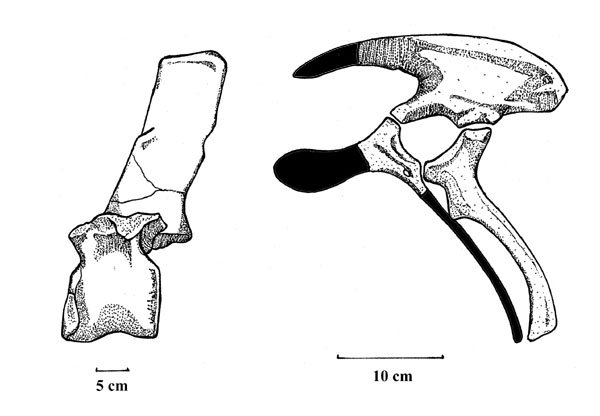
Genus: Barilium NORMAN, 2010
Etymology: Greek, barys, "heavy," and Latin, ilium, "flank"; in recognition
of the massive (and heavy) build of the holotype ilium and associated skeletal
remains attributed to this taxon.
= Kukufeldia McDONALD, BARRETT & CHAPMAN, 2010
Etymology: The generic name is derived from Kukufeld, an Old English name for
the village of Cruckfield, near the holotype was found. The generic name
is feminine.
= Sellacoxa CARPENTER & ISHIDA, 2010
Etymology: Latin, sella, "saddle" and Latin, coxa, "hips"; in reference to
the sddle-shaped ilium.
= Torilion CARPENTER & ISHIDA,
2010
Etymology: Latin, torus, "rounded" and Latin, ilion, "ilium": in reference
to the rounded postacetabular process.
Species: dawsoni (LYDEKKER, 1888) NORMAN, 2010
= Iguanodon
dawsoni LYDEKKER, 1888
Etymology: In honor of Mr. Charles Dawson.
= Torilion dawsoni (LYDEKKER, 1888) CARPENTER & ISHIDA,
2010
Holotype: NHMUK (BMNH) R798, R798b, R799, R800-R806, R4771, R4742
Locality: Shorden, Hastings, East Sussex County, England, Southern United Kingdom.
Horizon: Wadhurst Clay, Lower Wealden Formation, Hastings beds.
Biostratigraphy:
Age: Valanginian ranging from Ryazinian to Hautervian Stage, Middle Neocomian Subepoch, Lower Early Cretaceous Epoch, Early Cretaceous.
Material: Left ilium, wanting the extremity of the preaceetabular process, and the associated acetubular portion of the pubes of the same side, associated with BMNH R798.

NHMUK (BMNH) R798: Middle dorsal vertebra.
NHMUK (BMNH) R798a: Posterior dorsal vertebra.
NHMUK (BMNH) R802a: The proximal portion of the right tibia associated with BMNH R802.
NHMUK (BMNH) R799: A second left metatarsal associated with BMNH R802.
NHMUK (BMNH) R800: Proximal extremity of the second right metatarsal.
NHMUK (BMNH) R801: A larger crushed metatarsal, probably belonging to the 3rd digit.
Referred material:
NHMUK (BMNH) R966: A left scapula.
NHMUK (BMNH) R803, 804, 805: 5 trunk vertebrae associated with the proceeding.
NHMUK (BMNH) R806: the proximal portion of a chevron.
NHMUK (BMNH) R798b: A numerous series of trunk and caudal vertebrae associated with the preceding.
NHMUK (BMNH) R604: A series of more or less imperfect trunk and caudal vertebrae, apparently belong to the same individual as BMNH R811.
NHMUK (BMNH) R604a: A series of imperfect ribs, apparently associated with BMNH R604.
NHMUK (BMNH) R811: The imperfect centra of the sacrum and the associated left ischium, apparently belong to the same individual as BMNH R604.
NHMUK (BMNH) R811a: Fragmentary right pubis, apparently associated with BMNH R811.
NHMUK (BMNH) R1734: Cast of an almost entire late cervical vertebra.
Locality: Isle of Wight County, England, Southern United Kingdom.Horizon: Late Wealden Formation.
Biostratigraphy:
Age: Early Cretaceous.
Material:
NHMUK (BMNH) R136: Dorsal centra.
Note: This species belongs to the ‘Proiguandont Group’ per LYDEKKER, 1888.
= "Iguanodon" dawsoni GALTON, 2009
Locality: Old Roar Quarry, Saint Leonards, East Sussex County, England, Southern United Kingdom.
Biostratigraphy:
Age: Lower Valanginian Stage, Middle Neocomian Subepoch, Lower Early Cretaceous Epoch, Early Cretaceous.
Material:
NHM R3798: Pubis.
LYDEKKER, 1890Locality: Brede, East Sussex County, England, Southern United Kingdom.
Horizon: Wadhurst Clay, Lower Wealden Formation.
Biostratigraphy:
Age: Lower Valanginian Stage, Middle Neocomian Subepoch, Lower Early Cretaceous Epoch, Early Cretaceous.
Material:
NHMUK (BMNH) R1627: Fragmentary skeleton.
Brake down as follows:
NHMUK (BMNH) R1627a: Left scapula.
NHMUK (BMNH) R1627b: Shaft of a left humerus.
NHMUK (BMNH) R1627c: 2 thirds of a left ulna.
NHMUK (BMNH) R1627d: Middle portion of a right ilium.
NHMUK (BMNH) R1627e: Fragmentary right femur.
NHMUK (BMNH) R1627f: Shafts of 2 tibiae, and distal extremity of left tibia.
NHMUK (BMNH) R1627g: 3rd left metatarsals.
and 3 fragmentary caudal vertebrae.
NORMAN, 2011
Locality: Cuckfield, West Sussex County, England, Southern United Kingdom.
Horizon: Wadhurst Clay, Lower Wealden Formation, Hastings beds.
Biostratigraphy:
Age: Valanginian Stage, Middle Neocomian Subepoch, Lower Early Cretaceous Epoch, Early Cretaceous.
Material:
NHMUK R2357: Worn tooth.
= Barilium cf dawsoni
Locality: 'Old Roar Quarry', near Hastings, East Sussex County, England, Southern United Kingdom.
Horizon: Wadhurst Clay, Lower Wealden Formation, Hastings beds.
Biostratigraphy:
Age: Valanginian Stage, Middle Neocomian Subepoch, Lower Early Cretaceous Epoch, Early Cretaceous.
Material:
NHMUK R3789: Almost complete large sacrum.
Locality: West Marina, the quarry may have been linked to the construction of either the Marina Parade or St Leonards railway station, just to the west of Hastings, East Sussex County, England, Southern United Kingdom.
Horizon: Wadhurst Clay, Lower Wealden Formation, Hastings beds.
Biostratigraphy:
Age: Valanginian Stage, Middle Neocomian Subepoch, Lower Early Cretaceous Epoch, Early Cretaceous.
Material:
NYMUK R2357/R2358: Partial skeleton.
Locality: Buckshole Quarry, Hastings, East Sussex County, England, Southern United Kingdom.
Horizon: Wadhurst Clay, Lower Wealden Formation, Hastings beds.
Biostratigraphy:
Age: Valanginian Stage, Middle Neocomian Subepoch, Lower Early Cretaceous Epoch, Early Cretaceous.
Material:
NHMUK R2848: Articulated scapula, coracoid and femur.
Locality: Shornden Locality, Hastings, East Sussex County, England, Southern United Kingdom.
Horizon: Wadhurst Clay, Lower Wealden Formation, Hastings beds.
Biostratigraphy:
Age: Valanginian Stage, Middle Neocomian Subepoch, Lower Early Cretaceous Epoch, Early Cretaceous.
Material:
NHMUK R4746: Isolated right ilium.
= Kukufeldia tilgatensis McDONALD, BARRETT & CHAPMAN, 2010
Etymology: The specific designation combines the name of Tilgate Forest, West Sussex County, England, the region in which many of Mantell's fossils were obtained, and Latin, -ensis, 'from'.Holotype: NHMUK 28660
Locality: A quarry at Whiteman's Green, Cuckfield, West Sussex County, England, Southern United Kingdom.
Horizon: Grinstead Clay Membr, Tunbridge Wells Sand Formation, Wealden Group.
Biostratigraphy:
Age: Upper Valanginian Stage, Middle Neocomian Subepoch, Lower Early Cretaceous Epoch, Early Cretaceous.
Material: Nearly complete right dentary.
= Sellacoxa pauli CARPENTER & ISHIDA, 2010
Etymology: In honor of Gregory S. Paul for his recognizing the European iguandon diversity is far greater than formally recognized.Holotype: BMNH R 3788
Locality: Old Roar Quarry, Silverhill, Hastings, East Sussex County, England, Southern United Kingdom.
Horizon: Lower Wadhurst Clay, Hastings Beds Group.
Biostratigraphy:
Age: Lower Valanginian Stage, Middle Neocomian Subepoch, Lower Early Cretaceous Epoch, Early Cretaceous.
Material: Right ilium, pubis, ischium, and articulated posterior dorals and sacrals.
_____________________________________________________________________________________